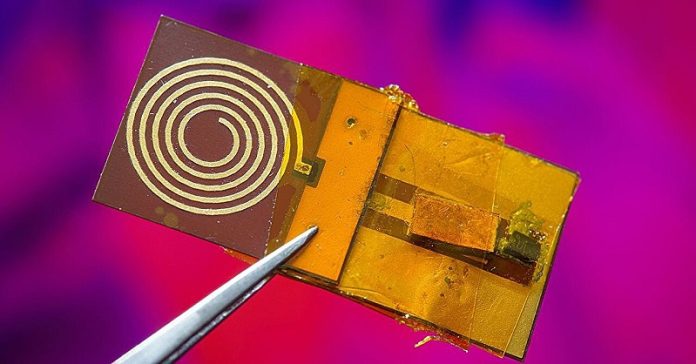
Imagine the excitement and possibilities when the realm of technology comes up with something that’s not only ingenious but also versatile and easy to use.
Researchers at the University of California San Diego have developed a new tool that’s about to make waves across various industries – introducing the wireless, battery-free electronic “force stickers”!
These thin, economical stickers have the magical ability to measure the force or pressure applied between two objects, and they can share this data without needing any wires or batteries.
To paint a picture of how they work, think of these force stickers like miniature, high-tech pressure sensors.
Picture a soft, squishy material sandwiched between two slim metal strips. When this sandwich is squeezed, the metal strips come closer together, and an electrical charge is created. It’s this charge that becomes our source of information about the force or pressure being applied.
A significant aspect of this invention is its power source – or lack thereof!
These stickers don’t need batteries because they employ a nifty trick using RFID technology (that’s the same tech used in things like contactless payment cards).
The RFID part sends out a signal that is altered by the aforementioned electrical charge. A reader picks up the returning signal and calculates the applied force, all without the sticker needing its own power source.
Let’s delve into a real-world scenario where this invention is proving beneficial. Consider the instance of knee implants in healthcare.
When doctors place an artificial knee joint in a patient, it’s crucial to monitor how it’s interacting with the body. How much pressure is it exerting on the surrounding area? Is it positioned just right?
With these force stickers, doctors can keep tabs on exactly what’s going on inside, ensuring that the implant is doing its job without causing any unforeseen issues.
This crucial information can be obtained wirelessly, avoiding additional surgeries or invasive procedures.
And the magic doesn’t stop at healthcare. Let’s take a stroll into a warehouse – a place where keeping track of inventory is crucial.
Placing force stickers on the bottom of packages means the weight of the contents can be continuously monitored, acting like a mini, self-sufficient scale that ensures accurate, real-time inventory data.
But what’s in store for the future of these brilliant little stickers?
Professor Dinesh Bharadia and his team envision them playing a pivotal role in multiple sectors, from making robots more sensitive to touch, to enhancing virtual and augmented reality experiences, and even acting as smart safety monitors for heavy machinery in industries.
But just like any technology, these stickers aren’t without their challenges. They currently require a calm and stable environment to function effectively and accurately, meaning bustling, dynamic settings throw them off a bit.
But not to worry! The team is hard at work evolving the technology, aiming to make it even more robust and versatile.
In a future where these force stickers might be as common and easy to use as slapping on a Band-Aid, imagine the endless possibilities where every touch, every force, and every pressure can be measured, analyzed, and understood, making our technologies smarter, more intuitive, and more integrated into our world.
The future is not just touch-sensitive; it’s force-aware, thanks to innovations like these.
Source: UC San Diego.



